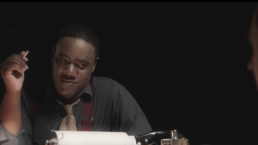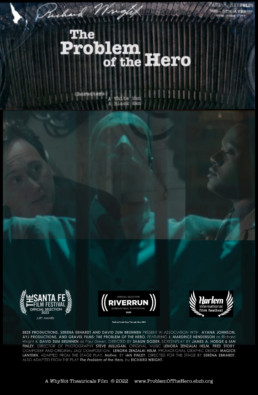The Problem of the Hero
Based on a true story about the author of Native Son, The Problem of the Hero sparks a philosophical debate about personal & creative agency.
As a storyteller, do you have the right to portray an experience other than your own? That is the overarching question in director Shaun Dozier’s film The Problem of the Hero. Running just shy of 90 minutes, the film is a fictional interpretation based on a real-life event that occurred between two 20th Century literary giants, sparking a philosophical debate about personal & creative agency.
The Problem of the Hero takes place in March of 1941, at the St. James Theatre in New York. American author Richard Wright (J. Mardrice Henderson), most famously known for his best-selling novel Native Son, and Pulitzer Prize-winning playwright Paul Green (David Zum Brunnen) have been collaborating to adapt the aforementioned Native Son into a Broadway play.
However, only days before the play is set to make its debut, Richard and Paul face a disagreement on how the play should end. The difference of opinion evolves into a deeper debate over issues of race, social justice, politics, and creative expression. Despite respecting each other’s points of view, the men find it hard to reach a solution, threatening to end their friendship and putting the play in jeopardy.
A couple of things are important to note here. First, Richard is a Black man, and Native Son was written partly based on his own experience growing up surrounded by racism in the American South. Paul, on the other hand, is a White man who has never personally experienced such hardships. Although he sympathizes with Richard’s struggles, he cannot truly empathize.
Ironically, the story of Native Son is a meta-reflection of what is playing out on screen between Richard and Paul. The book – which is referenced throughout the film when the characters act out scenes from the play – is a story about oppression and addresses the responsibility that White people have to create space for Black people to tell their own stories.
Shaun Dozier’s film is not a lighthearted affair, both thematically and visually. The cadence of the dialogue has a classic film-like quality to it with trans-American accents dominating the conversations. It is very dialogue-heavy as well, reminiscent of a stage play with intricate lines of dialogue bouncing between the characters. This non-traditional speaking style is a refreshing nod to the 1940s time period that Dozier is replicating.
Visually, The Problem of the Hero takes on a muted, slightly washed-out tone. Perhaps this is a budget-indicative choice but I believe the film could have benefitted from a sharper, more saturated color grade.
“We can only succeed as a society when we understand the things we haven’t experienced ourselves,” says Paul Green toward the film’s end. This sentiment is a divisive one that is still being argued today, as seen in the discourse surrounding Peter Farrelly’s Green Book, Kathryn Bigelow’s Detroit, and John Singleton’s 2013 Op-Ed in The Hollywood Reporter, “Can A White Director Make a Great Black Movie?”. The Problem of the Hero adds another perspective to this continued conversation and offers a point of view that will get audiences thinking.
Morgan Rojas
Certified fresh. For disclosure purposes, Morgan currently runs PR at PRETTYBIRD and Ventureland.


